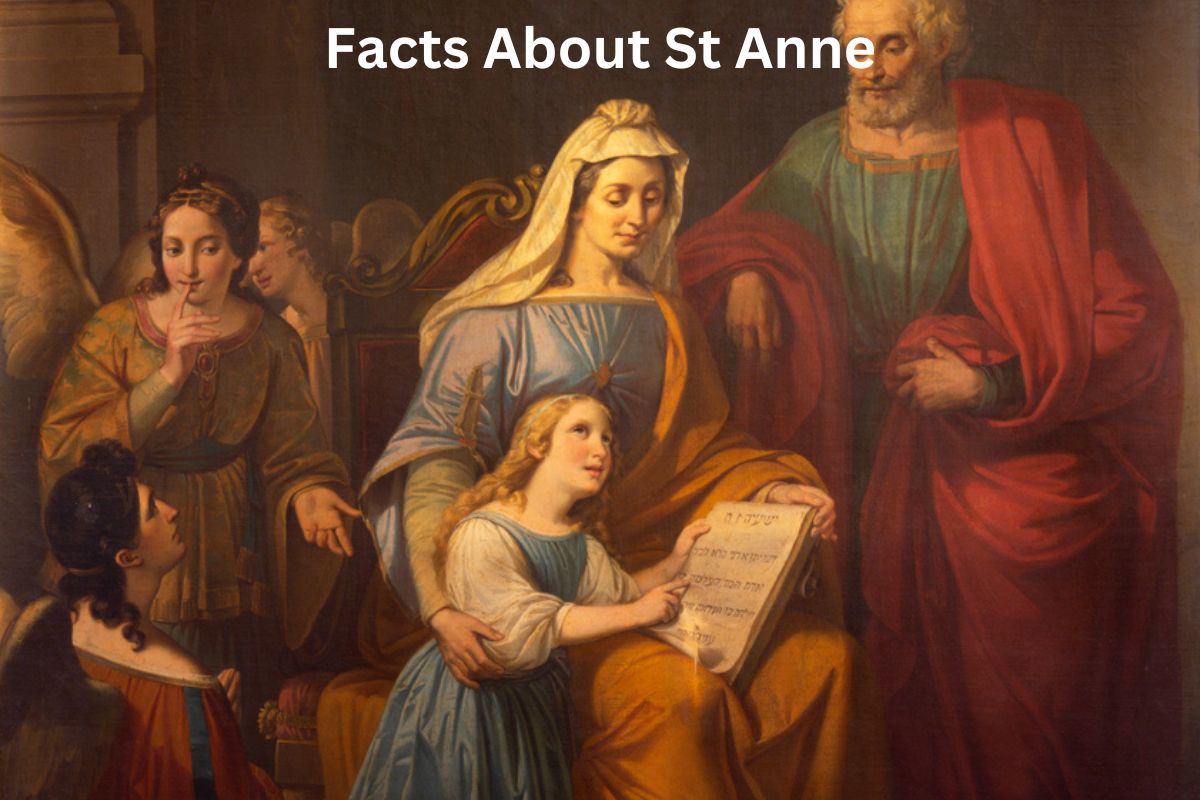St. Anne is a revered figure in Christian tradition, known as the traditional mother of the Virgin Mary and the grandmother of Jesus Christ.
Her story is primarily based on apocryphal texts and Christian tradition rather than the canonical Bible.
St. Anne’s feast day is celebrated on July 26th in the Roman Catholic Church, and her significance extends beyond her familial role, as she is associated with various professions and holds a special place in the hearts of those seeking intercession in matters of family and childbirth.
This brief introduction outlines the central aspects of St. Anne’s life and her enduring impact on Christian devotion and tradition.
St Anne Facts
1. St. Anne is the traditional mother of the Virgin Mary and grandmother of Jesus
St. Anne is a central figure in Christian tradition, particularly in Catholic and Orthodox Christianity. She is believed to be the mother of Mary, the mother of Jesus. This makes her the grandmother of Jesus according to Christian theology.
Also Read: Facts About St Patrick
While her role is not mentioned in the canonical Bible, her importance is derived from early Christian writings and traditions, which have been passed down through generations.

2. Her feast day is celebrated on July 26th in the Roman Catholic Church
The Roman Catholic Church celebrates the feast of St. Anne on July 26th each year. This day is dedicated to honoring her memory and seeking her intercession in matters of faith and family.
Also Read: St Augustine Facts
It is a special occasion for Catholics to reflect on the role of St. Anne in the story of salvation and to offer prayers for her guidance and protection.
3. St. Anne is not mentioned in the Bible but is part of Christian tradition
St. Anne’s absence from the canonical Bible is notable. Her story and significance are primarily found in apocryphal texts and Christian tradition.
One of the most well-known apocryphal texts related to St. Anne is the “Protoevangelium of James,” which provides details about her life, marriage to Joachim, and the miraculous conception of Mary.
Despite the lack of biblical mention, St. Anne’s veneration has been an integral part of Christian devotion for centuries, emphasizing the importance of oral tradition and early Christian writings in shaping religious beliefs and practices.
4. The “Protoevangelium of James” tells the story of her life
The “Protoevangelium of James,” also known as the “Gospel of James,” is one of the most important apocryphal texts related to St. Anne.
This text provides a detailed narrative of her life, including her marriage to Joachim, her barrenness, and the miraculous conception of Mary.
According to this text, an angel appeared separately to both Anne and Joachim, promising that they would conceive a child who would be dedicated to the service of God.
Mary’s birth is depicted as miraculous, signifying God’s divine intervention in their lives. This narrative has significantly contributed to St. Anne’s veneration and her role in Christian tradition.

5. St. Anne and her husband, Joachim, were childless for years before Mary’s birth
A key aspect of the traditional narrative surrounding St. Anne is her and her husband Joachim’s long-standing infertility. They were devout and righteous individuals who yearned for a child, but it seemed impossible due to their advanced age and Anne’s barrenness.
Their story of receiving divine intervention and the subsequent birth of Mary underscores themes of faith, perseverance, and the providence of God in fulfilling their desire for a child. It also serves as a precursor to the miraculous conception of Mary.
6. She is the patroness of women in labor and is invoked for childbirth
St. Anne is recognized as the patroness of women in labor and is often invoked by expectant mothers and couples seeking fertility or a safe childbirth. Many turn to her in prayer, seeking her intercession for a healthy pregnancy and delivery.
Her association with childbirth stems from her own miraculous conception of Mary and the belief in her ability to intercede on behalf of mothers and families during times of need.
Devotees often ask for her guidance and protection during the challenging and transformative experience of giving birth.
7. St. Anne is also associated with cabinetmakers and miners
St. Anne’s patronage extends beyond her role in family matters. She is also associated with certain professions and industries. One of the more unusual associations is with cabinetmakers.
This connection is derived from a play on words: her name “Anne” sounds like the Hebrew word “hannah,” which means “grace” or “favor.” This linguistic connection led to her being invoked by those involved in woodworking or crafting, as they seek the grace and favor necessary for their work.
8. Her feast day is celebrated with various customs and traditions worldwide
St. Anne’s feast day, celebrated on July 26th in the Roman Catholic Church, is marked by various customs and traditions in different parts of the world. These traditions may include special church services, processions, parades, and gatherings of the faithful.
Pilgrimages to churches and shrines dedicated to St. Anne are also common, where devotees seek her blessings and offer prayers of gratitude.
9. Many churches and institutions are dedicated to St. Anne
St. Anne’s widespread veneration has led to the establishment of numerous churches, chapels, and religious institutions dedicated to her honor.
These places often serve as focal points for devotion and pilgrimage, drawing visitors from near and far to pay their respects and seek her intercession. Some of these dedicated sites are known for their historical significance and architectural beauty.
10. She holds significance in the context of the Holy Family
St. Anne’s significance goes beyond her role as the mother of Mary and the grandmother of Jesus. She is an integral part of the Holy Family, which includes Mary, Joseph, and Jesus.
The Holy Family is a central concept in Christian theology, emphasizing the importance of the family unit and the roles of Mary and Joseph as the earthly parents of Jesus. St. Anne’s presence in this familial context underscores the sacred nature of the Holy Family and its role in Christian salvation history.
